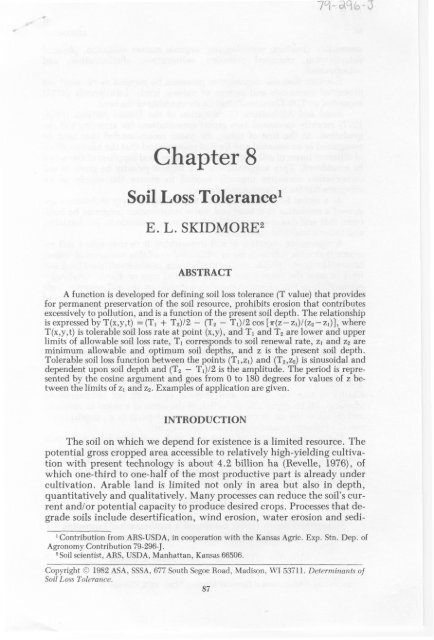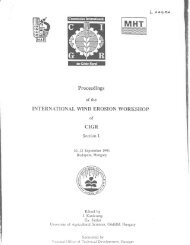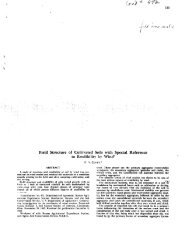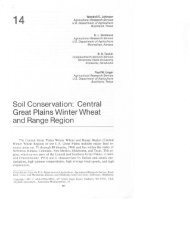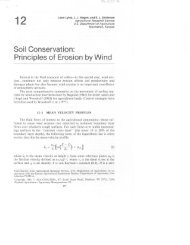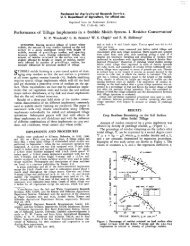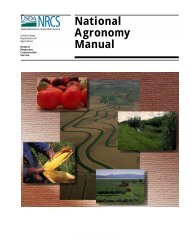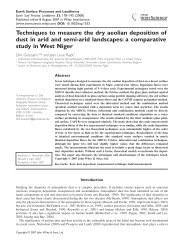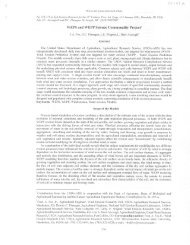Soil Loss Tolerance - USDA-ARS Wind Erosion Research Unit
Soil Loss Tolerance - USDA-ARS Wind Erosion Research Unit
Soil Loss Tolerance - USDA-ARS Wind Erosion Research Unit
You also want an ePaper? Increase the reach of your titles
YUMPU automatically turns print PDFs into web optimized ePapers that Google loves.
Chapter 8<br />
<strong>Soil</strong> <strong>Loss</strong> <strong>Tolerance</strong>'<br />
E. L. SKIDMORE2<br />
ABSTRACT<br />
A function is developed for defining soil loss tolerance (T value) that provides<br />
for permanent preservation of the soil resource, prohibits erosion that contributes<br />
excessively to pollution, and is a function of the present soil depth. The relationship<br />
is expressed byT(x,y,t) =(TI + T2)/2 - (T2- T1)/2 cos [T(Z-Z~)/(Z~-Z~)], where<br />
T(x,y,t) is tolerable soil loss rate at point (x,y), and TI and T2 are lower and upper<br />
limits of allowable soil loss rate, TI corresponds to soil renewal rate, z1 and zz are<br />
minimum allowable and optimum soil depths, and z is the present soil depth.<br />
Tolerable soil loss function between the points (Tl,zl) and (Tz,zz) is sinusoidal and<br />
dependent upon soil depth and (Tz- T1)/2 is the amplitude. The period is represented<br />
by the cosine argument and goes from 0 to 180 degrees for values of z between<br />
the limits of zI and z2. Examples of application are given.<br />
INTRODUCTION<br />
The soil on which we depend for existence is a limited resource. The<br />
potential gross cropped area accessible to relatively high-yielding cultivation<br />
with present technology is about 4.2 billion ha (Revelle, 1976), of<br />
which one-third to one-half of the most productive part is already under<br />
cultivation. Arable land is limited not only in area but also in depth,<br />
quantitatively and qualitatively. Many processes can reduce the soil's current<br />
and/or potential capacity to produce desired crops. Processes that degrade<br />
soils include desertification, wind erosion, water erosion and sedi-<br />
'Contribution from <strong>ARS</strong>-<strong>USDA</strong>, in cooperation with the Kansas Agric. Exp. Stn. Dep. of<br />
Agronomy Contribution 79-296-J.<br />
2<strong>Soil</strong> scientist, <strong>ARS</strong>, <strong>USDA</strong>, Manhattan, Kansas 66506.<br />
Copyright 0 1982 ASA, SSSA, 677 South Segoe Road, Madison, WI 53711. Determinants of<br />
<strong>Soil</strong> <strong>Loss</strong> <strong>Tolerance</strong>.<br />
87
88 SKIDMORE<br />
mentation, flooding, waterlogging, organic matter oxidation, physical<br />
deterioration, chemical pollution, salinization, alkalinization, and<br />
urbanization.<br />
Concern that soil degradation processes be stopped or reversed has<br />
prompted comments and actions of various kinds. Lowdermilk (1951)<br />
suggested an 11th Commandment on stewardship of the land.<br />
Food and Agriculture Organization of the <strong>Unit</strong>ed Nations (1974,<br />
1977) recently sponsored two expert consultations for assessing soil degradation.<br />
At the first of these, the panel recommended that land be<br />
recognized as an essential and limited resource and that the adverse effect<br />
of different forms of soil degradation on future food suppliers of the world<br />
be considered. They suggested that the highest priority be given to soil<br />
conservation measures urgently needed to ensure the supply of an<br />
adequate diet for increasing populations.<br />
At a recent board meeting, the <strong>Soil</strong> Science Society of America approved<br />
a resolution that land and water conservation programs be instituted<br />
that will conserve our vital soil resource, maintain its productivity,<br />
and foster a healthful environment.<br />
A reasonable objective of soil stewardship is to maintain a soil resource<br />
that with judicious use of additional available resources of water,<br />
favorable climate, plants, and technology can produce sufficient food and<br />
fiber to meet the present and future needs of man on Earth. Obviously,<br />
accomplishing this objective depends not only on the soil resource itself<br />
but also on other resources that enhance soil productivity and the demand<br />
created by the world population. However, we will limit the following<br />
discussion to considerations of soil loss tolerance on cultivated cropland.<br />
Our objective is to develop a usable function for defining tolerable soil loss<br />
which includes the concepts developed by Stamey and Smith (1964).<br />
They suggested that the definition of erosion tolerance must (1) provide<br />
for the permanent preservation or improvement of the soil as a resource,<br />
(2) be adaptable to the erosion and renewal rates of any soil characteristic,<br />
(3) be a function of position since at any two points on the<br />
Earth's surface the erosion and renewal rates will not necessarily be<br />
identical, (4) be applicable regardless of the cause of erosion or renewal,<br />
and (5) allow the use or depletion of any soil property (e.g., depth) in excess<br />
of present or predictable future requirements.<br />
Conceivably, erosion of some soils such as a deep loess soil could<br />
cause more serious environmental problems than impairment of a soil resource.<br />
This suggests the need for another element in the definition of soil<br />
loss tolerance: (6) prevent erosion from contributing excessively to pollution<br />
and other environmental problems.<br />
METHODS<br />
Stamey and Smith (1964) developed a mathematical expression for<br />
erosion tolerance at point (x, y) of some measurable soil property.<br />
I(x,Y) - S,"[E(x,y,t) - R(x,y,t)l dt 2 M(X,Y) [I1<br />
See minutes of SSSA Board of Directors' Meeting, 7 Dec. 1978, Chicago, Ill.
SOIL LOSS TOLERANCE 89<br />
Table 1. The various combinations of limits for the curves of Fig. 1.<br />
Curve TI Tz ZI Z2<br />
mm/yrt - m-<br />
a 0.2 2.0 0.5 0.8<br />
b 0.2 2.0 0.5 1.2<br />
C 0.2 2.0 0.5 1.6<br />
d 0.2 2.0 0.5 2.0<br />
e 0.2 1.6 0.5 2.0<br />
f 0.2 1.2 0.5 2.0<br />
& 0.2 0.8 0.5 2.0<br />
t When a soil has a bulk density of 1.0 glcm3, multiply millimeters per year by 10 to convert<br />
to metric tons per hectare per year.<br />
where I(x,y) is the position function, which gives the value of the measure<br />
of the soil property at the initial time (to; M(x,y) represents the minimum<br />
allowable value at (x,y) of the measure of this property; and E(x,y,t) and<br />
R(x,y,t) represent the erosion rate and renewal rate, respectively, of the<br />
measurable soil property. Equation 1 defines the concept that net change<br />
tolerance [E(x,y,t) - R(x,y,t)] integrated over time subtracted from the<br />
initial value of the measurable soil property must always exceed the minimum<br />
allowable value. However, very little progress has been made in the<br />
last 15 years to define the function of Eq. [ 13 so that it is of practical use.<br />
Consider the following equation for defining tolerable degradation<br />
of some measurable soil property at point (x,y). For illustration and discussion,<br />
let us apply the equation to soil depth, although it could be used<br />
for other measurable properties, both extensive and intensive.<br />
T(x,y,t) = (Ti + T,)/2 - (T2 - T1)/2 COS [T(X - zi)/(z2 - zl)]<br />
Where Ti is the lower limit of allowable rate of change of soil property<br />
at point (x,y) (here it represents soil loss per annum); T(x,y,t) equals TI<br />
when soil depth is at minimum allowable value so that net change function<br />
of Eq. [l] equals zero. In other words, j: [E(x,y,t) - R(x,y,t)]dt<br />
equals zero and P(x,y) equals M(x,y), where P(x,y) is the present value of<br />
the soil property depth.<br />
The upper limit of allowable soil loss rate at point (x,y) is T2; T(x,y,t)<br />
equals T2 when soil depth is great enough so that a further increase in soil<br />
depth would not further enhance the productive capacity of that soil at<br />
point (x,y); z is the present value P(x,y) of the soil property at point (x,y);<br />
z1 is the minimum allowable value of the soil property at point (x,y),<br />
[M(x,y) of Eq. 13; and zz is the optimum or target value O(x,y) of the soil<br />
property at point (x,y). At this point, increasing the value of z2 would not<br />
further increase the productive capacity of that soil at point (x,y). Ti 5<br />
T(x,y,t) I T2 as M(x,y) I P(x,y) I O(x,y). The relationship between the<br />
limits of TI and T, for allowable soil loss and zI and zz for soil depth is<br />
sinusoidal. The amplitude is (T2- T1)/2.<br />
Period is represented by [(z- zl)/(z2 - Z~)]T of the cosine argument<br />
and ranges from zero to r radians or 180 degrees for values of z between<br />
the limits of z1 and z2. The first term of Eq. [2] is simply an amplitude offset.<br />
T(x,y,t) connects the extreme points (Tl,zl) and (T2,z2) with a slope of<br />
PI
90 SKIDMORE<br />
2.0<br />
L<br />
><br />
\<br />
E<br />
E 1.6<br />
W<br />
0<br />
z<br />
1.2<br />
a<br />
W<br />
J<br />
e<br />
fn<br />
fn<br />
s<br />
.a<br />
t f"<br />
e<br />
.5 1 .o 1.5 2.0<br />
SOIL DEPTH, meters<br />
Fig. 1. <strong>Soil</strong> loss tolerance as a function of soil depth for various combinations of limits.<br />
zero. That is, as the present value P(x,y) of the soil property depth gets<br />
closer to M(x,y), the change in T(x,y,t) with change in P(x,y) goes to zero<br />
and T(x,y,t) = R(x,y,t).<br />
<strong>Soil</strong> loss tolerance as a function of soil depth, as defined by Eq. [2] for<br />
various combinations of limits (Table l), is illustrated by Fig. 1. Each<br />
curve shows the values of T for the full period or half cycle of the cosine<br />
function. The lower limits were held constant. The minimum allowable<br />
soil depth M(x,y) was chosen at 0.5 m; renewal rate R(x,y,t) was chosen at<br />
0.2 mm/year.<br />
APPLICATION EXAMPLE<br />
Suppose we wished to determine appropriate soil loss tolerances for a<br />
soil at (x,y) that was 1.4 m deep. We judged that the production capacity<br />
of that soil would increase with depth up to 2.0 m and that a depth of 0.5<br />
m would be the minimum allowable. <strong>Soil</strong> renewal rate is 0.2 mm/year.<br />
We determined that maximum soil loss should never exceed 2.0 mm/year.<br />
Then, using Eq. [2], we calculated tolerable soil loss as 1.38 mm/year, or<br />
about 14 metric tonslha-year.<br />
When different values for present value of soil depth are substituted<br />
into Eq. [2], curve d of Fig. 1 is generated. As the soil depth approaches<br />
either limit of soil loss tolerance, the slope of the curve approaches zero.<br />
Now we must answer the questions: How fast does the soil depth<br />
change with time if soil depth changes according to soil loss tolerance (T<br />
value), and in what manner does T value change with time This was
SOIL LOSS TOLERANCE 91<br />
done by solving Eq. [3] and substituting P(x,y) for z back in Eq. [2] for n<br />
= 2,000 iterations.<br />
where the variables are as defined previously. The results are shown in<br />
Fig. 2. <strong>Soil</strong> depth decreases rather quickly with time from the initial value<br />
of 1.4 m, then levels off with time as the T value approaches the soil renewal<br />
rate (0.2 mmlyear).<br />
Now, for another example, suppose that a very deep soil of uniform<br />
depth had 0.5 m soil that could be removed without affecting its current<br />
or future productivity. Furthermore, we assumed that z1 and z2 are 1.0<br />
and 1.5 m, respectively; and TI and T2 are 0.1 and 2.0 mm/year, respectively.<br />
In this case, Eq. [2] and [3] yield the results shown in Fig. 3. <strong>Soil</strong><br />
loss tolerance remains constant at the maximum value until soil depth<br />
equals 1.5 m, then decreases as soil depth decreases below 1.5 m.<br />
DISCUSSION<br />
In these applications, reasonable values for the upper and lower<br />
limits of T value and soil depth were assumed. The key to the successful<br />
use of Eq. [2] in describing soil loss tolerance lies in the rationale and procedure<br />
for determining limit values. Some may argue that we do not need<br />
the upper limit of T value because only the lower limit is important in<br />
permanently preserving the soil resource. However, knowing the upper<br />
limit is important for meeting criterion No. 6. Clean Air Amendments<br />
(1970) and Federal Water Pollution Control Act Amendments (1972) will<br />
not allow us to perqit wind and water erosion to occur without<br />
consideration of the environment. Also, we should guard against soil loss<br />
where the damage costs to the environment are greater than the costs of<br />
preventing the loss.<br />
Figures 2 and 3 indicate that soil depths change rather slowly with<br />
time for the conditions of these examples. In these cases, the renewal<br />
function was constant. We need more information on renewal rates for<br />
specific locations and conditions and how renewal rates can be accelerated.<br />
Renewal rates from weathering of the basalt underlying shallow<br />
loess soils in the Pacific Northwest is slow as compared with those of shale<br />
parent material of some soils in the Southeast. We should not permit soil<br />
loss to proceed to the extent that it lowers the producing capacity of the<br />
soil, either immediately or in the long-term, more than it would cost to<br />
prevent the loss.<br />
The minimum allowable soil depth could be defined in terms of the<br />
present soil depth andlor, according to the judgment of local soil scientists,<br />
the depth of soil required to preserve high-level crop production. Results<br />
now being obtained on reclaiming drastically disturbed lands should<br />
give additional insights into depth and quality of soil needed for<br />
particular production levels.
92 SKIDMORE<br />
1.4<br />
1.2 %<br />
\<br />
E<br />
E<br />
1.0 -<br />
W<br />
0<br />
z<br />
.8 2<br />
w<br />
I<br />
I-<br />
n<br />
W<br />
n<br />
cn<br />
cn<br />
.4 3<br />
I I I I I I I I I 0<br />
0<br />
0 2 4 6 8 10 12 14 16 18 20<br />
ELAPSED TIME. centuries<br />
Fig. 2. Change in soil depth and T value as soil loss proceeds at the tolerable rate.<br />
2.0<br />
1.8<br />
1.6<br />
- 1.0<br />
I F<br />
n .8<br />
W<br />
n<br />
.6<br />
i<br />
0 .4<br />
UJ<br />
.2<br />
2.0<br />
1.8<br />
1.6<br />
1.4<br />
1.2<br />
1 .o<br />
.8<br />
.6<br />
.4<br />
.2<br />
L<br />
\<br />
E<br />
E<br />
W<br />
0 1 I I l l l l l l l l l l l l l l l l I l O<br />
0 2 4 6 8 10 12 14 16 18 20<br />
ELAPSED TIME, centuries<br />
Fig. 3. Change in soil depth and T value as soil loss proceeds at the tolerable rate.<br />
The optimum soil depth could also be defined in terms of the present<br />
soil depth or according to the judgment of soil scientists who know local<br />
conditions and limiting resources. In addition to meeting T values, we<br />
should increase the quantity and quality of the soil resource wherever the
SOIL LOSS TOLERANCE 93<br />
cost of doing so is lower than the value of the increased production<br />
capacity.<br />
So far we have discussed the soil property depth as if it were measurable,<br />
which it is. However, we must establish some guiding criteria for<br />
that measurement. Do we measure A + B horizons, rooting depth of commonly<br />
grown crops, depth to impervious layer, or something else, and do<br />
we establish a weighting factor for quality of soil material giving more<br />
credit to the more desirable topsoil These questions and those pertaining<br />
to defining limits can be answered best by consensus of concerned and<br />
knowledgeable scientists representing various groups like the <strong>Soil</strong><br />
Conservation Service, Agricultural <strong>Research</strong>, and Cooperative State <strong>Research</strong><br />
Service.<br />
With appropriate limits, Eq. [2] would satisfy criteria for defining<br />
erosion tolerance mentioned earlier and be very useful for determining T<br />
value. Then, using the WEQ (Woodruff and Siddoway, 1965; Skidmore<br />
and Woodruff, 1968) and the USLE (Wischmeier and Smith, 1978), we<br />
can implement erosion control practices to maintain a soil resource that<br />
can produce food and fiber to meet our present and future needs.<br />
LITERATURE CITED<br />
Clean Air Amendments of 1970. 1970. Public Law 91-604. U.S. Code Congressional and<br />
Administration News. 1954-2001.<br />
Federal Water Pollution Control Act Amendments of 1972. 1972 Public Law 92-500. U.S.<br />
Statutes at Large 86:816-903.<br />
Food and Agriculture Organization of the <strong>Unit</strong>ed Nations. 1974. A world assessment of soil<br />
degradation-an<br />
international programme of soil conservation. Report of an expert con-<br />
sultation on soil degradation, Rome. 40 p.<br />
_--- . 1977. Assessing soil degradation-report of an FAOIUNEP expert consultation,<br />
Rome, FA0 <strong>Soil</strong>s Bull. 34. 83 p.<br />
Lowdermilk, W. C. 1951. Conquest of the land through seven thousand years. <strong>USDA</strong>, SCS,<br />
MP-32.38 p.<br />
Revelle, Roger. 1976. The resources available for agriculture. Sci. Am. 235:164-178.<br />
Skidmore, E. L., and N. P. Woodruff. 1968. <strong>Wind</strong> erosion forces in the <strong>Unit</strong>ed States and<br />
their use in predictingsoil loss. <strong>USDA</strong>, <strong>ARS</strong>, Agric. Handb. No. 346.42 p.<br />
Stamey, W. L., and R. M. Smith. 1964. A conservation definition of erosion tolerance. <strong>Soil</strong><br />
Sci. 97:183-186.<br />
Wischmeier, W. H., and D. D. Smith. 1978. Predicting rainfall erosion losses-a guide to<br />
conservation planning. <strong>USDA</strong>, Agric. Handh. No. 537. 58 p.<br />
Woodruff, N. P., and F. H. Siddoway. 1965. A wind erosion equation. <strong>Soil</strong> Sci. SOC. Am.<br />
Proc .29:602-608.


